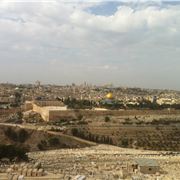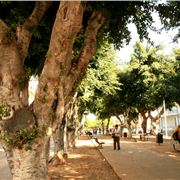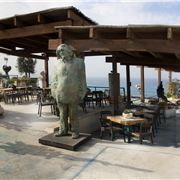IF I had chosen any day in the last 20 years to visit the city of Tel-Aviv, I could scarcely have selected a more turbulent one than the day after the Israelis had killed senior Hamas leader Mahmoud al-Zahar.
So by the time I set off the media had all colluded to convince me that I would doubtlessly return with fewer limbs.
This thought was reinforced as I was bundled out of my plane seat and shepherded into a nearby ground floor porch, along with about thirty Israeli women who were in a blind panic and had resorted to praying.
I wasn't expecting a red carpet on my arrival but this was ridiculous.
For a press trip designed to show-off the tourist attractions of Tel-Aviv the timing was clearly awry. It was lonely out there too, all the other British journalists had cancelled as soon as they heard of the trouble. I was the literally the last man standing.
Carmel Market
After practicing the recovery position over and over while totting up my net worth for negotiation with Hamas, I set off to my first destination. It was to be Carmel Market. An eclectic array of produce greeted me. Fresh spices, vegetables and a humorously named olive oil stand.
 My Favourite Stall at Carmel MarketTowards the final part of the market, necklaces, bracelets and questionably authentic sportswear were amongst goods offered. The atmosphere of the market was unmistakeably Middle Eastern, with swathes of people jostling for spices. Tel Aviv's market visitors don't seem particularly patient customers, but then I've never shopped under the threat of bombardment.
My Favourite Stall at Carmel MarketTowards the final part of the market, necklaces, bracelets and questionably authentic sportswear were amongst goods offered. The atmosphere of the market was unmistakeably Middle Eastern, with swathes of people jostling for spices. Tel Aviv's market visitors don't seem particularly patient customers, but then I've never shopped under the threat of bombardment.
As well as the beautiful smells and sights that greeted me in the market, I also came across a young man who I was told was suffering from the 'Messiah Complex'. He look like a cartoon caricature of Jesus, and was convincingly letting people know they needed to both be nice and give money to him to ensure a painless transition into heaven. No-one seemed to mind being propositioned, and treated him as a novelty, I certainly did. In fact when I returned to the market in the evening I was pleasantly surprised to find that he had managed to persuade a few people of his divinity, and had even acquired a guitar that he was playing.
The area around Carmel boasts an exciting array of bars and clubs, The Monastery being one of the most popular amongst the locals. Serving local beers and small snacks, the outdoor area was always packed until the early hours. The turbulent political situation seemingly not dissuading any locals from enjoying themselves.
Jerusalem
Just a 45 minute drive from the centre of Tel-Aviv is the holiest part of the Holy Land. I was told by every local that if you have a couple of hours spare, Jerusalem is an essential visit. The religious buildings have been changed on almost a century by century basis, the major monotheistic religions taking it in turns to move their things in and have a quick re-decorate of the place. The buildings are already up, its much easier to just change the windows and colour of the marble rather than build a new one.
 View From The Mount of OlivesFirst stop on the religious tour to end all religious tours is the Mount of Olives, home to the most expensive graves on the planet. To make this place your final resting spot it could cost you a cool £7,000, in return for that though you do get a queue jump to the promised land when Jesus returns - according to Christians. It is a vast area, 10,000 graves and counting, provides a sinister backdrop for the main town of Jerusalem. However the view is stunning.
View From The Mount of OlivesFirst stop on the religious tour to end all religious tours is the Mount of Olives, home to the most expensive graves on the planet. To make this place your final resting spot it could cost you a cool £7,000, in return for that though you do get a queue jump to the promised land when Jesus returns - according to Christians. It is a vast area, 10,000 graves and counting, provides a sinister backdrop for the main town of Jerusalem. However the view is stunning.
The Dome of the Rock dominates the landscape, the enormous golden dome dwarfing the other mosques, churches and temples that surround it.
Next to the Mount is the Church of St. Mary Magdalene. Legend has it that Jesus slept here after the Last Supper but before being betrayed by Judas. The Church has been rebuilt many times since then, but is remarkable. Stunning marble columns lead the eyes to a huge dome decorated in blue and white, with gold olive branches lining the walls.
As I moved deeper into Jerusalem, I came to the Western Wall. This was when I was hit by the full force of religion and the impact it has had on the this smallish Middle Eastern city.
Jewish pilgrims were coming in from eveywhere. Some had clearly saved for decades to look at the Western Wall, have a wail and pop a handwritten note into the wall for God to answer. Even the omnipotent One would struggle to individually grant all these wishes, there must have been tens of thousands of requests in the section of wall that I inspected alone.
Beyond the Western Wall is the Arab quarter of Jerusalem. The markets here were beyond anything that existed in Tel-Aviv. There were the same questionably authentic sportswear items for sale, but in addition there were religious cards, trinkets and accessories that undermined the 'holy' experience. Mammon more than God. There is something strange about standing on the very street that Jesus walked with the cross on his back, whilst being able to buy a Nike tracksuit.
On the roads towards the Church of the Holy Sepulchre were some of the most impressive shops I had seen in Israel. These apparently sold genuine Roman sculptures, vast Russian canvases and some of the most enormous religious iconography you could imagine. For some of the pieces you could expect to pay up to £4000.
The fervent religious fanaticism was saved for the Christian quarter.
The main Church of the Holy Sepulcre is an enormous structure and stunning architecturally. Inside significant points of interest stack up.
The size of the queue of people lining up to kiss the stone that Jesus' blood allegedly spilled onto during the crucifixion was almost absurd - religion eh? Christians who had flocked from all over the world to see it were wailing and weeping. Of course it might have been that they had all simultaneously realised that the Adidas hat they had just bought wasn't genuine, but they did all seem genuinely moved.
Rothschild Boulevard, Tel-Aviv
 Rothschild BoulevardBauhaus architecture abounds in this beautiful street, with tourists from all over Europe flocking to see the blend of east/west influence on the design. The feast of design culminates in the most aesthetically pleasing McDonalds that I have ever laid eyes on, very McQuaint it was.
Rothschild BoulevardBauhaus architecture abounds in this beautiful street, with tourists from all over Europe flocking to see the blend of east/west influence on the design. The feast of design culminates in the most aesthetically pleasing McDonalds that I have ever laid eyes on, very McQuaint it was.
The American influence on eateries and bars was thankfully relatively absent for the most part in Tel Aviv.
Starbucks attempted to open a coffee shop just off Rothschild Boulevard near McDonalds, but struggled to attract sufficient customers to their particular brand of coffee.
Rothschild Boulevard and the surrounding area is really the centre of Tel-Aviv where nightlife is concerned. The street hosts an enormous amount of bars and restaurants and the choice is sometimes baffling.
The Social Club was our eatery of choice, and was excellent. The atmosphere was cosmopolitan, with an array of businessman conversing over meals. The service was professional and attentive and the food was superb. I chose the speciality fish which was known as the 'Denise', a fish dish, and followed starters of Humous and a Mint Salad.
Post meal, you are equally spoilt for choice for drinking destinations. My bar of choice was Nanutchka. A charming place, with quaint, Classical decoration (another example of the stylistic differences in architecture around Rothschild Boulevard). A friendly welcome and a great choice of drinks added to the relaxed atmosphere of bars and clubs in the area.
 The Bustling Bar at Radio EPGBFinally, for a late night drink, Radio EPGB is a top destination. Crammed with all manner of party goers, it is an underground watering hole that is very distinctive. Known for its diverse music and cheap drinks it was a popular destination for the locals with an enormous queue outside by the time I left at 2am. Give it a miss if you are looking for a conversation however, the music was loud enough to make the furniture bleed.
The Bustling Bar at Radio EPGBFinally, for a late night drink, Radio EPGB is a top destination. Crammed with all manner of party goers, it is an underground watering hole that is very distinctive. Known for its diverse music and cheap drinks it was a popular destination for the locals with an enormous queue outside by the time I left at 2am. Give it a miss if you are looking for a conversation however, the music was loud enough to make the furniture bleed.
Florentine Neighbourhood
The neighbourhood of Florentine was until recently a run down, poor suburb of Tel-Aviv. A Tel-Avivian soap called 'Florentine' that followed the lives of young, trendies changed all that. It has transformed into a bohemian area, bursting with artists, intellectuals and coffee houses.
It lies near the extortionately expensive Neve Tzedek Neighbourhood. It consists of modern apartments to cater for the wealthy young professionals who are moving from the wealthier North of Tel Aviv to the newly trendy South.
A stones throw from Neve Tzedek is the Israeli Defence Force's museum. Unsurprisingly, museums showcasing decommissioned weapons and artillery aren't particularly popular during air raids so the place was almost deserted. Certainly worth a look though, if only to see young girls who have just been called up to Israeli National Service having a look at their first machine gun at age eighteen. Bizarre.
The Museum is situated on the newly refurbished Jaffa railway station, known as Manshiya. With its cafe's, coffee houses and trendy clothing stores as well as occasional craft markets, it's a very picturesque spot just on the edge of Jaffa. It was the subject of an air-raid strike on the day I visited. This time the selected shelter was a shop that sold puzzles and jigsaws.
Port of Jaffa
Following the beach to the south will bring you to the ancient port of Jaffa. The Old City is a treat to look at, traditional architecture is everywhere, and has remained largely unchanged for centuries.
 A Street in Old JaffaThe port was originally created to transport oranges out of Tel-Aviv to the rest of the world. Many or the old warehouses still remain and have been converted into art galleries, restaurants and apartments. Towards the promenade these warehouses have been turned into expensive restaurants, designer clothing retailers and swanky bars that stretch all the way to the end of the pier.
A Street in Old JaffaThe port was originally created to transport oranges out of Tel-Aviv to the rest of the world. Many or the old warehouses still remain and have been converted into art galleries, restaurants and apartments. Towards the promenade these warehouses have been turned into expensive restaurants, designer clothing retailers and swanky bars that stretch all the way to the end of the pier.
One of these restaurants is Kalimera. The setting is lovely for an evening meal, right on the edge of the old port. They specialise in seafood, much of which is locally caught and was the culinary highlight of the trip by far. The fresh squid was sublime, as was the salmon. It is an idyllic spot to take in the sunset, offering perfect views of the Old City and the port.
Undoubtedly one the most interesting buildings in Jaffa, and perhaps even Tel-Aviv as a whole, is the Ilana Goor Museum. The building dates back to 1742. The art and sculpture showcased within is nearly as pretty as the view of the coastline from the rooftop.
The museum is Goor's private home in addition to it showcasing her own work, plus work from many other distinguished artists and sculptors from across the world. These include luminaries such as Diego Giacometti and Henry Moore.
 Ilana Goor Rooftop ViewThe particular highlight for me was the kitchen. All fully functional, it mixed modern electrical appliances with North African sculptures and work surfaces, whilst embracing the glorious view of the connecting coast through enormous windows.
Ilana Goor Rooftop ViewThe particular highlight for me was the kitchen. All fully functional, it mixed modern electrical appliances with North African sculptures and work surfaces, whilst embracing the glorious view of the connecting coast through enormous windows.
The Jaffa flea market is a bargain hunter's delight. I have never seen quite such an array of things for sale at any other market. Much of it was utterly useless to anyone, one particular vendor was selling a collection of old keys for example. Another man had a well used collection of dirty American magazines from the 80s which were gaining much interest, mainly from the other salesmen. Amongst the tat were some interesting prints and occasional handmade rugs.
Negotiating through the keys, second hand trainers and sunglasses with lenses missing can be rather draining. So to rejuvenate yourself there is no better place for lunch than Dr Shakshuka, in the heart of the Old City of Jaffa.
Named after the signature dish, this place was a real find. The Shakshuka comprises of sausages, egg, tomato and herbs all fried in a rich sauce and is served with bread. It is an effective pick me up for the weary traveller.
Though the timing of my visit proved far from idyllic, I found Tel-Aviv a cosmopolitan and rewarding city. The variety of communities and diverse array of food, art and cultures that co-exist in such a small area offers a visiting experience that is bewitching. Watching the vapour trails of belligerent in-coming missiles was a crazy extra to that. One that usually doesn't figure on the average tourist trip.
Fact File
Eating and Drinking;
Kalimera, Jaffa Port, Tel-Aviv
Social Club, 45 Rothschild Street, Tel-Aviv
Dr. Shakshuka, Beit Eshel 3, Jaffa, Tel-Aviv
Monastery Bar (Haminzar), 60 Alenbi Street, Tel-Aviv
Radio EPGB Bar and Club, Shandal 7 Street, Tel-Aviv
Nanutchka Bar, 28 Lilenblum Street, Tel-Aviv
Seeing;
Carmel Market, 39 Hacarmel Street, Tel-Aviv
Manshiya Railway, Hacarmel Street, Tel-Aviv
Ilana Goor Museum and Art Gallery, 4 Mazal Dagim Street, Old Jaffa, Tel Aviv, ilanagoor.com
Tel-Aviv Segway Tour, http://www.segwaytlv.co.il/
Port of Jaffa, Old Jaffa, Tel-Aviv
Israel Defence Forces History Museum, Yehezkel Kaufmann Street, Tel-Aviv
Rothschild Boulevard Architectural Tour, Rothschild Boulevard, Tel-Aviv
Flights and Accommodation;
Crowne Plaza Tel Aviv, 145 Hayarkon Street, Tel-Aviv, http://www.ichotelsgroup.com/
Jet2 Airlines, Flights from £149, Jet2.Com










